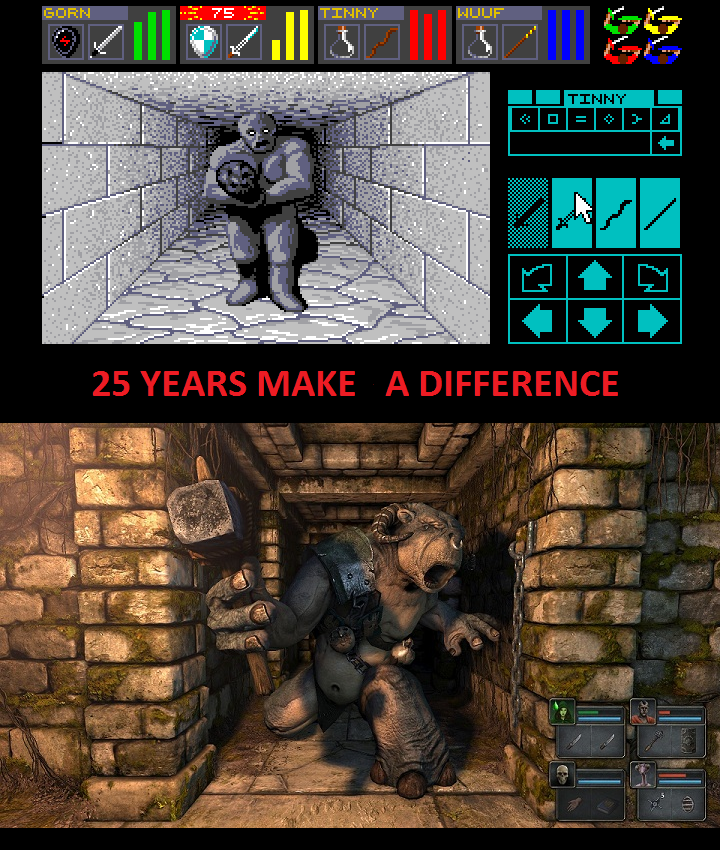StoppedInTracks
Member
Hey all it's the fourth part of my mini-almanach. This time all the text is NOT MINE as I did not finish the titles below. Hope you enjoy this trip down the memory lane!
Part 1: http://www.neogaf.com/forum/showthread.php?t=469298
Part 2: http://www.neogaf.com/forum/showthread.php?p=36706516#post36706516
Part 3: http://www.neogaf.com/forum/showthread.php?p=36728077#post36728077
The Elder Scrolls: Arena
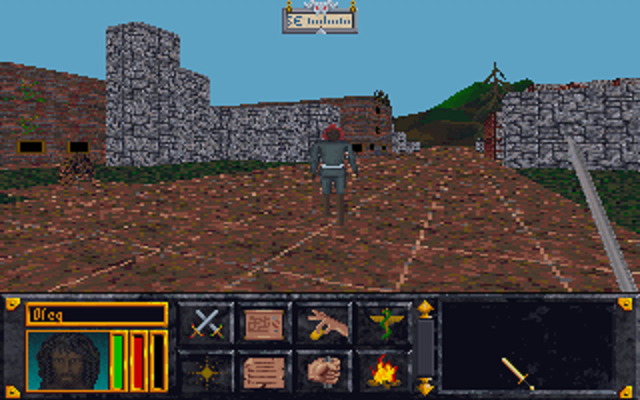
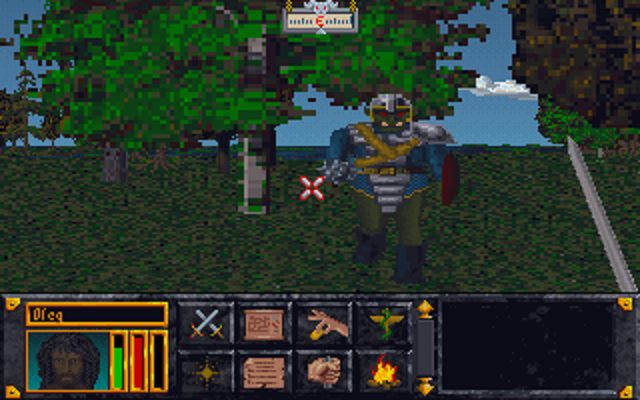
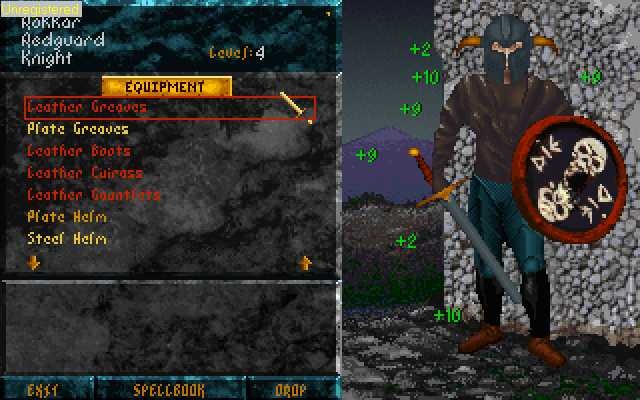
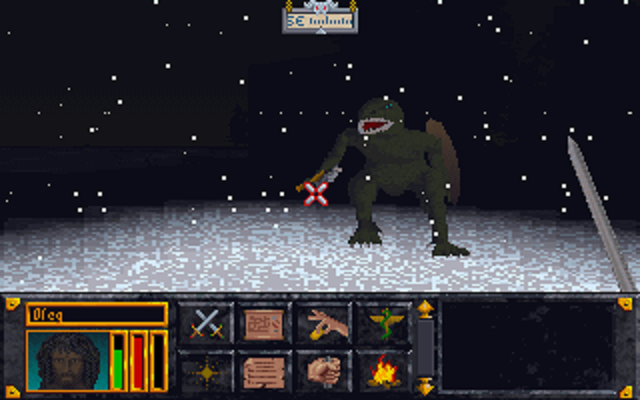
Download here!: http://www.elderscrolls.com/arena/
GameFAQs mrtzeentch says:
The Elder Scrolls series has become pretty famous in recent times. Games like Morrowind and even Daggerfall saw pretty big success. But most people forget about Arena, the game that started it all. At the time of its release (and even today possibly) it was the biggest world ever created for a game. It had thousands of towns, dungeons, and thousands more items and spells. It was absolutely enormous. In more recent games, you've been confined to certain areas of Tanriel (the game's world) In Daggerfall, you were confined to Highrock and Hammerfell, but in Arena, you could travel to ANY part of the world. In those days, technology was not what it is now, obviously, so most areas seemed generic, but in truth there was alot ot them. Each area's native people had their own attitudes and bias. Example, when travelling in Morrowind, a High Elf was not always treated with a whole lot of respect. The game centered around you searching for pieces of a staff that had been broken. The typical RPG quest in most respects, but this one had you travelling all over the world. You've got alot ot do too. You don't have to do the main quest of course. You can always just roam around collecting treasure. There are tons of items to be found too. Artifacts (unique items) are definitely present here. You'll see alot of them, but they are much harder to find than in Morrowind.
The Elder Scrolls II: Daggerfall
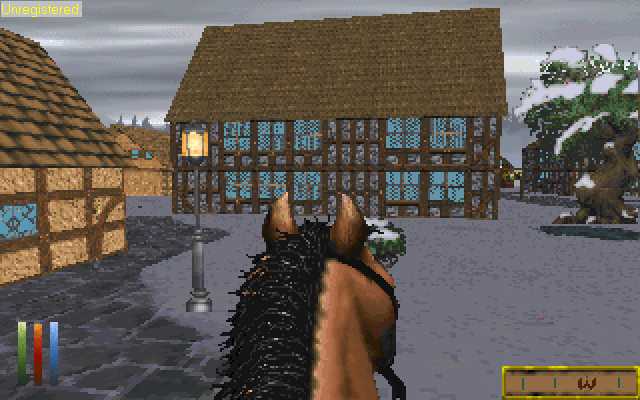
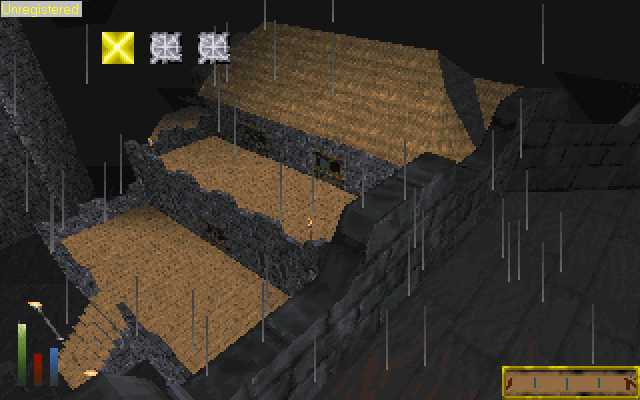
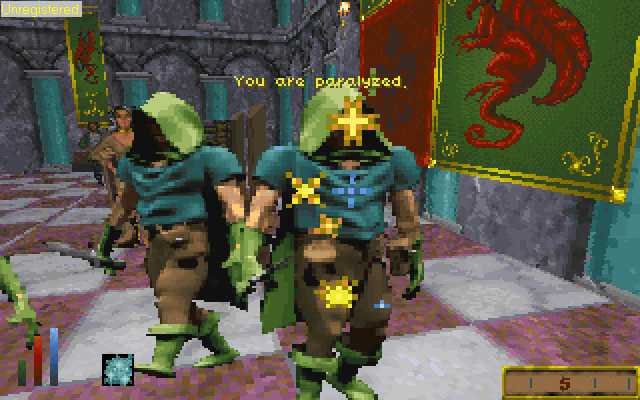
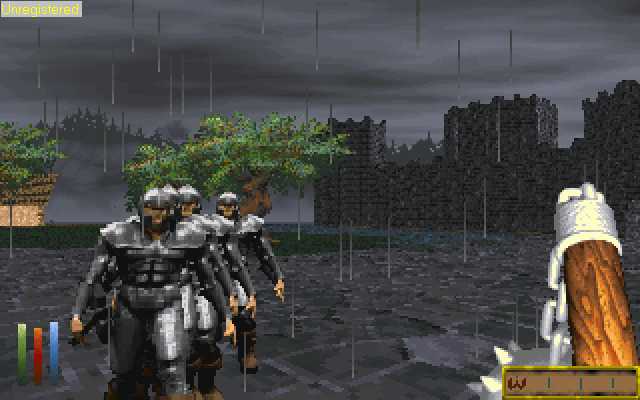
Download here!: http://www.elderscrolls.com/daggerfall/
GameFAQs Zamble says:
TES: Daggerfall is simply one of the most amazing RPGs of all platforms available. It's just as complete as a computer game can be, but, unfortunatelly, it is also one of the games with the biggest number of bugs ever released - just like Ultima Online. Daggerfall is a first-person solo RPG with a good storyline. You are in a secret mission given by the Emperor himself to you, with the objective of investigate and exorcise the hauntings of the City of Daggerfall, where the ghost of the former King of Daggerfall screams "Vengeance!" every night. Also, the Emperor has sent a letter to the former Queen of Daggerfall years ago, and he wasnts you to find out if it was ever delivered or whatever happened to it. Nice, isnt it? Then you are sent in a boat to the Kingdom of Daggerfall...but a strange storm sinks your ship and you end up in a dark cave, from where you have to get out and then resume your mission.
The downsides of the game are also big. It's full of bugs. You'll be walking around in a dungeon and, all of a sudden, you'll penetrate the floor and won't be able to come back! Or you may notice some items disapearing from your inventory with no explanation... the list of bugs go on. Many paths have been released to solve them, and most of the logical bugs have been fixed (like not being able to spleep inside of your own house) but the problems with "falling to the void" like mentioned beffore remain, as well as random crashes. Also, Bethesda Software didn't keep their promise on all the features they said the game would have, like the clothes your character is wearing influencing NPC reaction. Anyway, if you can live with the bugs, you'll love the game as much as I did.
Descent to Undermountain
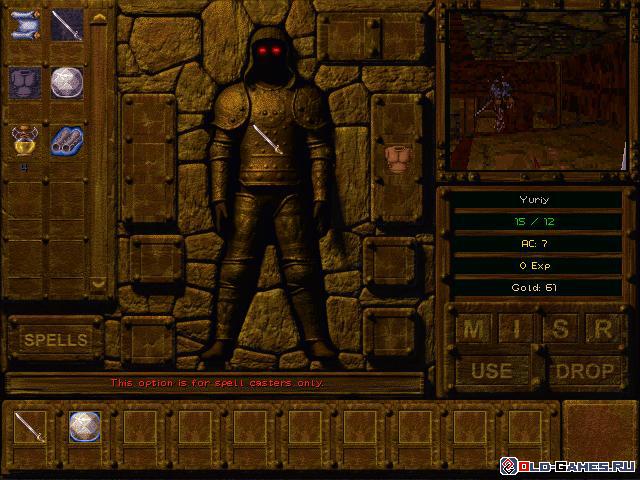
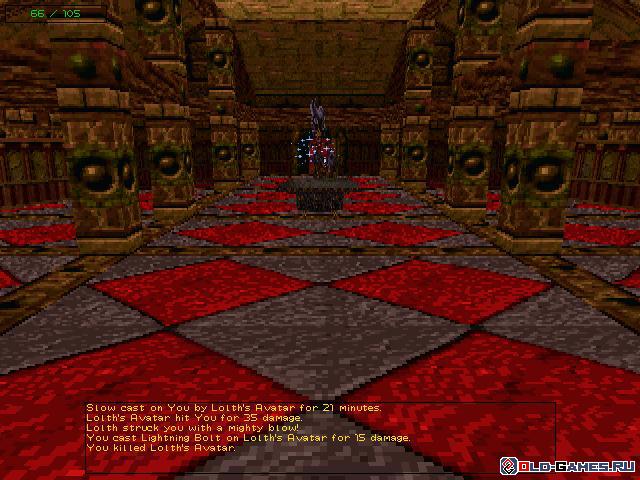
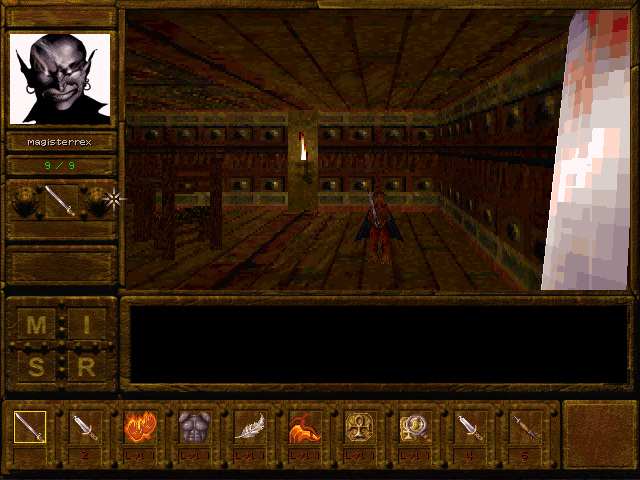
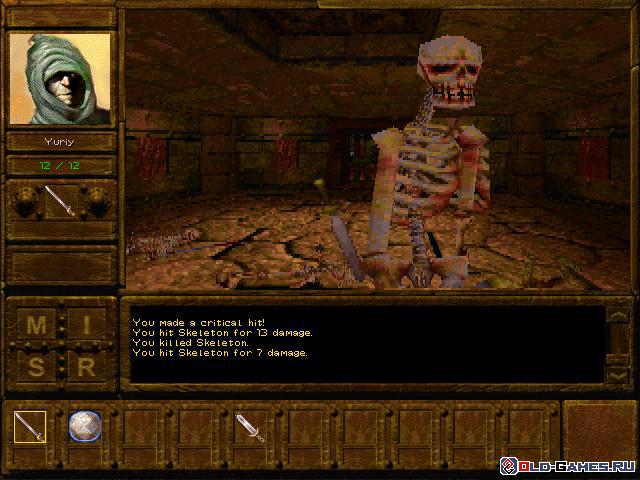
eBay
GameSpot says:
It seemed like such a great idea when we first heard about it nearly three years ago: Combine the fantasy world of AD&D with the award-winning Descent engine. The concept sounded tantalizing, so much so that many thought the result would surely be an experience that would do nothing less than completely revitalize the ailing fantasy role-playing genre.
But somewhere along the line something went horribly wrong, and now gamers are asking themselves two questions. The first arose merely out of befuddlement: How could the company that produced Fallout also be responsible for one of the lousiest games to come down the pike in quite a while? The second, though, addresses a much more serious issue: Why did Interplay ship the thing when it wasn't even close to being the sort of cutting-edge product the hype machine had led us to believe it would be?
There's probably no way to learn the answer to the first question, but - thanks to some very frank members of the Descent to Undermountain team - the answer to the second is now common knowledge. The game went out when it was scheduled to go out (in time for a Christmas release) even though it wasn't ready. That's not just me speculating; that's precisely what a member of the DTU team stated in a recent post on Usenet.
Descent to Undermountain is set in the AD&D Forgotten Realms world, but judging from the game's visuals it should probably be renamed "Forgotten Graphics." I haven't seen a major game title that looked so dreary, so blocky, and so downright unappealing in years. It's tempting to lay the blame on the 256-color palette, but I've seen plenty of games using only 256 colors that looked a damn sight better than this mess.
Nearly every location - or at least all the ones I visited during the time I endured the game - is awash in brown, giving everything a samey look that only adds to the monotonous feeling that settles over you from the moment you begin your first quest. And pixels? Man, you ain't seen nothin' until you've roamed around a bit in DTU - these blocks are as big as a baby goblin and twice as irritating. The worst part, though, is that at Interplay's DTU web site you'll find all sorts of claptrap about how many textures are used and how advanced the graphics are. They've even got the nerve to compare this wretched mess with Quake! I guess there's nothing quite as intoxicating as the wings of hubris fluttering about your head in a time of crisis....
But the horrors don't end there. A lot of the monsters you meet seem to have learned how to defy gravity itself: Giant rats float in midair, bats that have been hacked to death hover several feet off the ground, and even an undead skeleton can somehow manage to stay three feet off the floor. I guess that getting rid of all the zero-gravity stuff in Descent was just too much of a stumbling block for whomever it was who "rewrote" the Descent engine for this game.
Even if everything in DTU were picture-perfect, this would still be a derivative game, treading the same path of all the AD&D computer games that inundated the market from the late 1980s into the early 1990s. But if it looked good and played smoothly there'd at least be some happy AD&D fans right now; as it stands, no one's happy, and in fact, a lot of people are downright angry. The lesson to be learned should be obvious: If you're gonna ride the hype machine, you'd better deliver the goods. Sadly, DTU doesn't even come close - and the worst part is that sometime over the next year or so we'll probably see this same story played out all over again.
So what have we learned today? That pushing a product out the door before it's ready makes loyal customers angry; that game developers should keep at least one eye on what's going on in terms of technology when working on a new game; and that if you buy Descent to Undermountain after reading this, you get what you deserve.
Wizardry VI: Bane of the Cosmic Forge

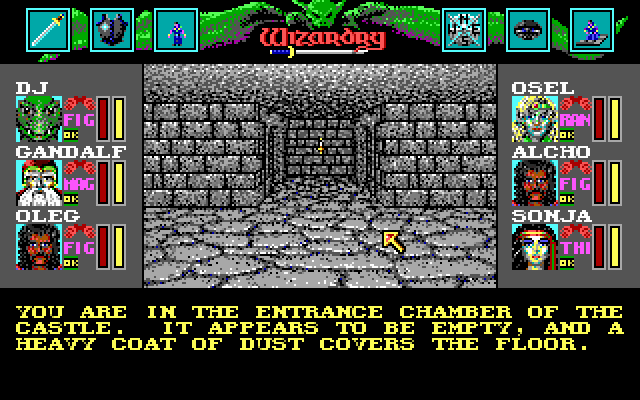
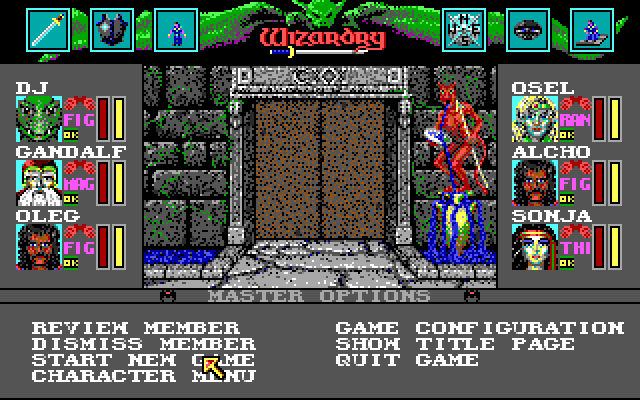
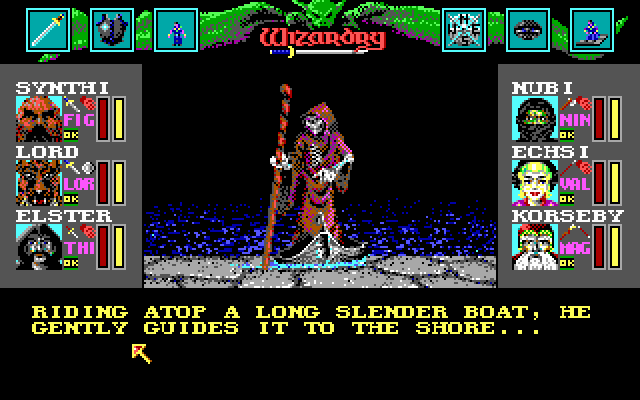
GameFAQs Jitawa says:
Bane of the Cosmic forge marks a turning point for the Wizardry series, and is the first game in the "trilogy" started by D.W. Bradley. All told, Wizardry changed little from 1 to 5, and this title made an attempt to distinguish the series from its peers.
Story is where this game really shines. Consider that the majority of rooms you walk into are going to look exactly the same. Flavor text is present for pretty much every area of the game that serves to set up the particular room or area you may have just entered. Your characters aren't given any default personality, and so the text serves to assign a fairly objective (if slightly cynical and bemused) perspective to the player's party. The descriptions of the Queen's bedroom and stashed clothes are fairly amusing for example.
The story itself is fairly original for the time, and the manner in which the drama unfolds piece by piece, character by character is very satisfying. You start the game digging in the past, and eventually find yourself embroiled in the present political situation of the area. The game affords you multiple endings, which was also rather unusual for the time. Better still, the endings can be used to import your characters to the sequel with unique ramifications and starting area depending on which ending you got.
This game was a massive overhaul from the previous Wizardry games. Instead just a few stock fantasy races and classes -- the roster was expanded to include 4 main schools of magic and several new races and classes. The classes were expanded to include a caster for each school (basically, there was the classic mage/priest and the added alchemist and psionic). All told there were 11 races and 14 classes. Gender played a fairly minor roll in the game, with a very few items being gender specific, and only one class having that restriction (Valkyries had to be female).
I must confess that I have a certain bias for the classic western RPG. Wizardry is a series that created the mold for early RPG incarnations like Might & Magic or Bard's Tale. This game expands on basic wizardry, and really lends itself to replay with different sets of classes and such (Much like Final Fantasy I, but with more options). I've personally beaten it over ten times, and I wish I could go back to the first time I won it when all the battles and puzzles were still brand new. If you're considering or have played Wizardry 7, consider playing this one first and bringing your party through the games in order. In terms of story and gameplay - this is truly an RPG classic.
Wizardry 8




eBay
GameFAQs Kujila says:
In the world of RPG series there are three juggernauts - Origin's "Ultima", New World Computing's "Might and Magic" and Sir-Tech's "Wizardry". These three produced games with many descendents and even spin-offs of the fantasy world.
Now, the Wizardry series has always been aimed more at 'hardcore' RPGers. Crusaders of the Dark Savant lacked the alluring graphics of Ultima and Might and Magic, but instead delivered the most challenging RPG ever created. The game faced you against innumerable foes more powerful than yourself, had you cross the world of Guardia in search of an artifact known as the Astral Dominae. Wizardry, like Might and Magic, fused technology with fantasy with fantastic results. The battle against the technology of the Dark Savant never seemed contrived or ludicrious. Magic clashed against technology as rival factions battled on Guardia and NPCs travelled freely, affecting the entire thread of the game.
However, after Wizardry 7, the series seemed to have ended. Unlike Ultima and Might and Magic, new games were not being churned out on an almost annual basis, although many gamers were still grappling with the T'rang and the Savant. Then Sir-Tech finally released Wizardry 8, and unlike Origin and New World Computing, they have finished their legacy with their greatest game ever.
And what a great game it is.
Wizardry 8 is born in a time where RPGs are gaining lustre and losing substance. Pretty-but-shallow games like Neverwinter Nights are now the face of the RPG genre. Morrowind is almost legendary merely because it has the graphical edge that the superior prequel Daggerfall could not use to attract customers. They are slowly but surely melding with the other genres, losing the challenge and depth that RPGs were defined by.
It seemed that the days of the truly great history-defining RPGs like Wizardry 7, Ultima VII and Might Magic III were gone. Certainly a few great games rose here and there - the Fallout series, Sir-Tech's own 'Shadows over Riva', and Planescape: Torment (which I have not played yet have heard nothing but praise for.) But until Wizardry 8, it seemed that the great RPG was not what it used to be.
I don't give games 10/10. 10/10 means perfection, and in my opinion no game is perfect. I'm the sort of reviewer that reserves 9/10 for the best games and will never even consider 10/10 - but this is different. Because I truly believe that Wizardry 8 is such a rare and wonderful game that it deserves this unattainable reward. If you played Crusaders of the Dark Savant, then this will be an almost spiritual experience. Or maybe I just need to get out more.
Dungeon Master
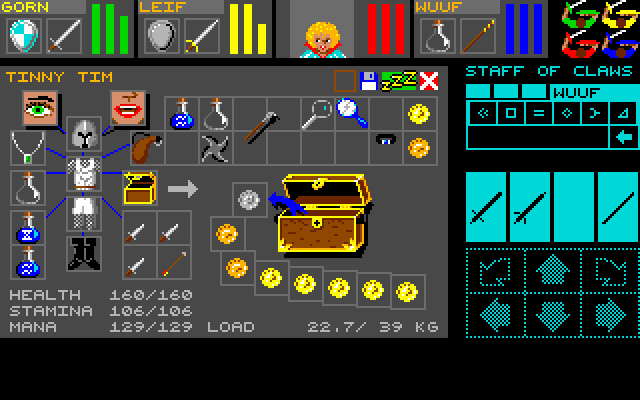
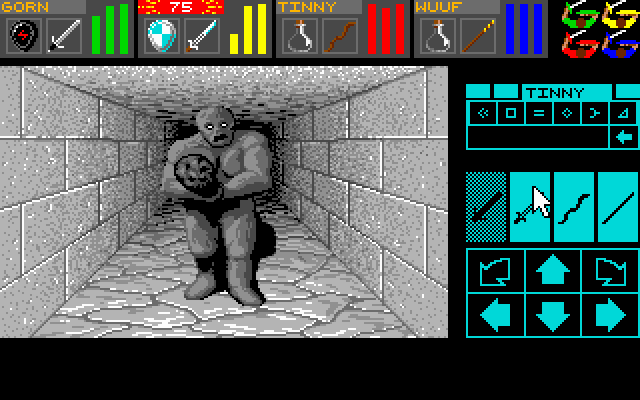

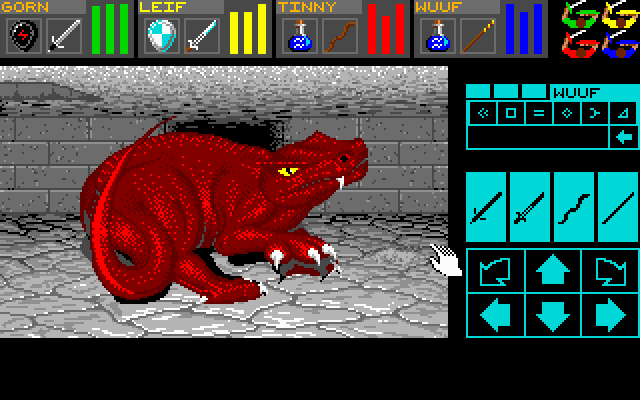
eBay
Internet user Reup says:
Dungeon Master isn't just a game, it's a religion. Even though the game was made in 1987 for the Atari ST (and a PC port was made two years later) the fanbase is quite big today. This 'mother of all rpg's' was certainly groundbreaking when it appeared, both in gameplay and graphics. The 3D first person perspective was still rather unheard of in those days, as most games were side- or topview. The fact that you'd have a team of 4 characters that you could each specialise and the huge dungeon to explore made it an instant hit. The sheer amount of ports for this game for every operating system and 3d engine you can imagine proves that Dungeon Master isn't forgotton at all!
There's not much to explain about this game. Everything that's in a decent RPG nowadays is also found in Dungeon Master, only a bit more primitive. After you've chosen your Champions you start to search the dungeon, venturing deeper and deeper. Each character has an inventory with plenty armor and equipment slots as well as a large enough packback. They need to eat, drink and sleep now and again to regain there powers. You can find food in many rooms, and in the remains of some enemies, and water from fountains all over the place.
This is a must-have for any RPG or dungeon crawler fan, but everyone else should give it a try as well. Read the background story in the manual to get in the mood and the technical details about spell-casting and you're ready to go! The game 'only' gets a four, because I really missed some moody music in the background. It was probably left out due to memory limitations back then, but still it's a shame. If for some reason you want to try the game in a more modern jacket, you can play one of the many clones (some of which have been made using high-tech 3d engines) or the Java version which is an accurate copy of the original, only with better graphics and sound-effects.
Legend of Grimrock
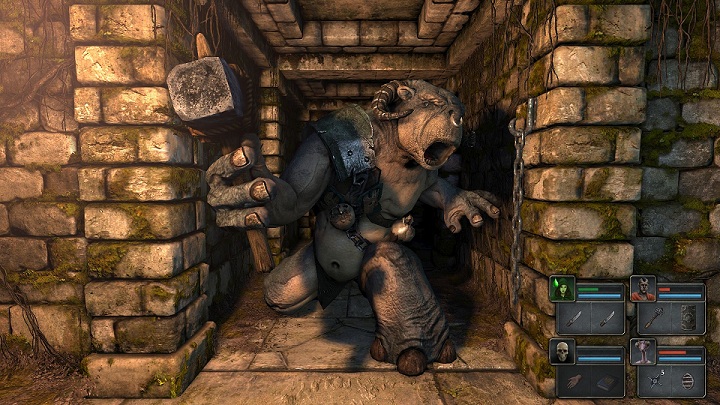
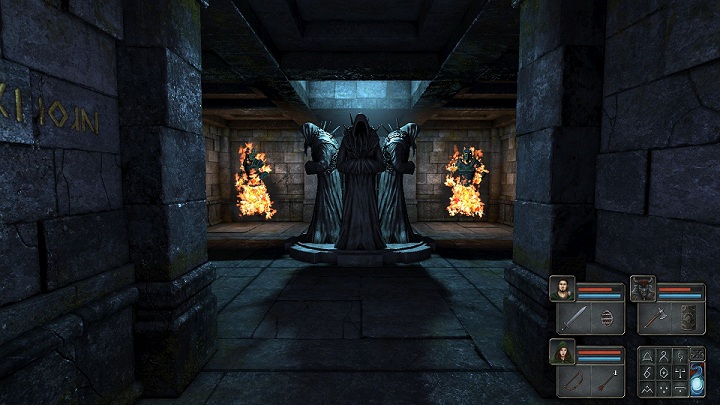
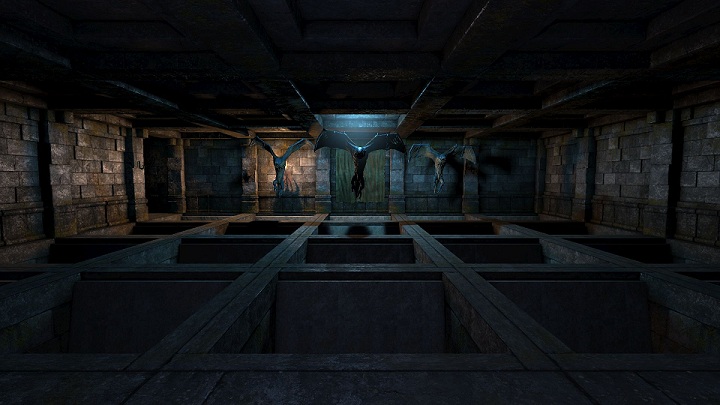
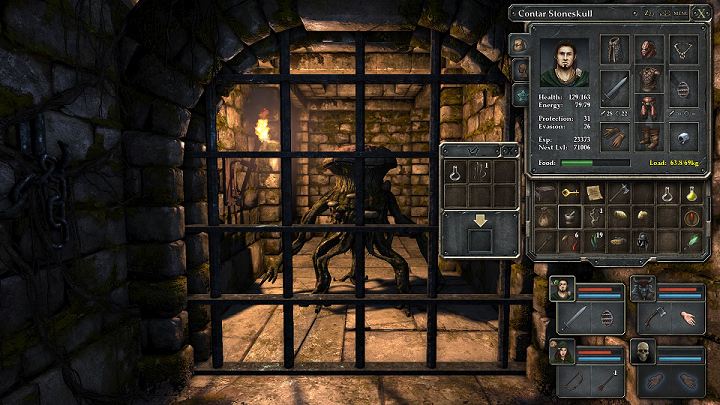
Hey a 2012 title!
Buy it here: http://www.grimrock.net/buy/ (and I mean it!)
UK IGN review says:
As a kid, I grew up rolling d20s, charting out hand-scrawled labyrinths on graph paper swiped from math class, and concocting elaborate fantasy worlds to explore. And when I wasn't sitting around a table with my pals debating the finer points of casting Magic Missiles instead of Delayed Blast Fireballs, I spent my free time affixed to a clunky old PC playing games like Eye of the Beholder and Dungeon Master. Digging into Almost Human's shiny new take on hardcore old-school dungeon crawlers is a warm fuzzy trip down memory lane, but one of the most impressive things about Legend of Grimrock is the way it showcases how well the classic formula holds up after so many years.
Hand-picking your four-member party is preferable to diving in with the pre-made group, and there's a good balance between accessibility and depth in the character crafting menu. While class selection is sadly limited to fighters, rogues, and mages, cool racial perks and selectable bonus traits add enough variety to the mix to keep things interesting. Insectoids, for example, make great back-line spellcasters due to their heightened intelligence and naturally hardened carapace, while burly minotaurs are solid front-row combatants that get an attack boost for every human skull they're holding in their inventory. Leveling-up characters earns you skill points to dump into a broad range of weapon, armor, spell, and ability specializations, unlocking new perks and boosting your combat prowess in the process. Since the real fun comes from diving into the dungeons to amass powers and gear as you go, I appreciate that it only takes a minute or two to lock and load your crew without sacrificing depth in the character customization department.
Only a few steps into the first dungeon level, it's easy to get swept away by the thick, potent atmosphere of Grimrock's underground realm. The dank moss-and-root entwined stone walls feel ancient and almost alive, particularly as the warm torchlight casts shadows across their crisp detailed surface. Other nuances, like mysterious earthquakes, strange voices that appear in your dreams, and the foreboding sound of scurrying creatures stalking you in the distance add to the tension that slowly builds as you explore. There's something ominous afoot, and it feels like it could emerge at any second to destroy you. You also never know what you'll encounter when rounding the next corner or opening a locked door, and the eerie vibe plays well off the need to scour every nook and cranny for invaluable loot.
Underneath its gorgeous sheen and striking atmosphere, Legend of Grimrock is an unapologetic nod to PC gaming's earlier days. Playing it reawakens those same feelings of excitement I had back when I got into early dungeon crawler RPGs for the first time. There's something magical about the skillful way the dev team takes such antiquated game design and makes it feel new and fun again, pushing all the right nostalgia buttons in the process. But more importantly, everything about this well-crafted romp through deadly dungeons comes together to pull you into its mysterious realm and hold on.
Mazes of Fate
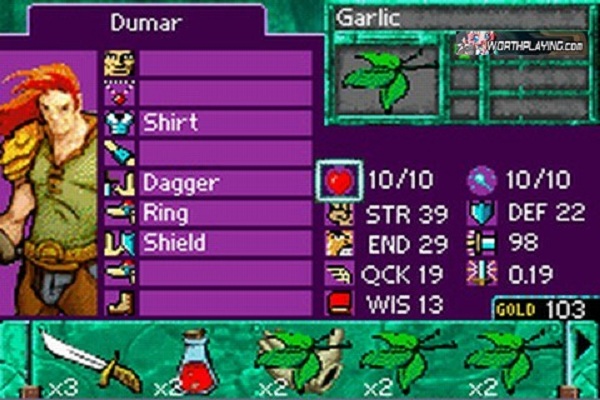
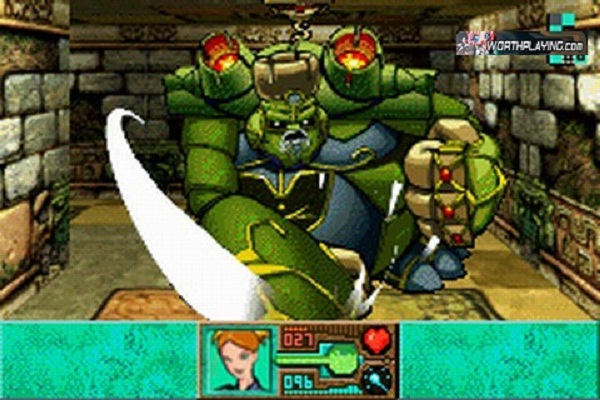
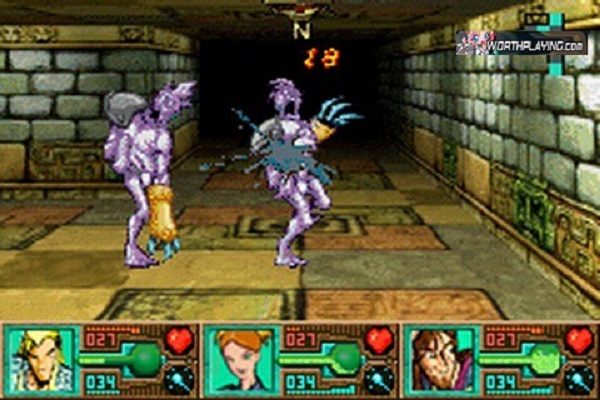
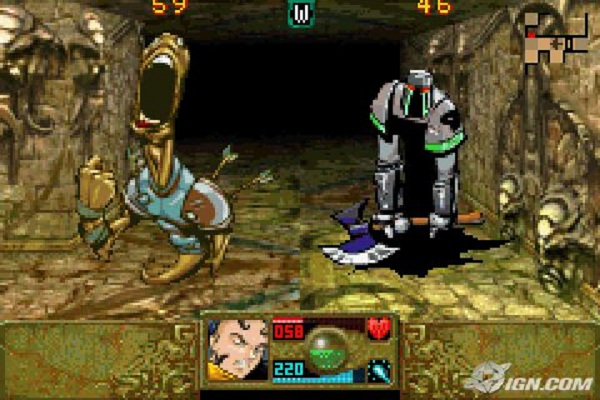
eBay
GameFAQS clarkisdark says:
The first console my family owned was a TI-99/4A. At my young age, it was hard to enjoy any of the games we had, but one I always came back to was Tunnels of Doom. It was an RPG dungeon crawler that frustrated me to no end. The game expected me to remember what I named my characters, but I always gave them long and complicated names, and I'd forget who was who when it was time to tell somebody to pick up an item. I didn't touch the dungeon crawler design again for several years. In fact, I'd forgotten all about it. So it's somewhat refreshing and nostalgic to come across Mazes of Fate, a game whose design is firmly rooted in the RPGs of old.
But Mazes of Fate's main draw is its first-person dungeons. First-person anything on the GBA has rarely worked out, but the effect here is handled flawlessly and recreates the feeling of an old-school dungeon crawler without any hitches. The monsters within are also drawn with the same care as the game's human characters, but their animations are a tad stifling. With only one or two basic animations per monster, it's kind of distracting when compared to the rest of the game. But when compared to the rest of the genre on the GBA, I'd say Mazes of Fate is doing very well.
The dungeons here are complicated, sometimes spanning three or four floors with all the dead ends and locked doors you hoped you'd never see in an RPG. I spent almost two hours in the first big dungeon, and it about drove me crazy. Granted, there is a map screen you can consult which shows you every hallway and room you've previously seen. So backtracking or finding areas you haven't visited yet is convenient. It's just that these dungeons are so big. It all looks the same, too, and it can get pretty tiring spinning around in circles and constantly relying on a map. Monsters are a frequent threat in the meantime. But this isn't like your usual RPG where monsters pop out of nowhere to challenge you in yet another random battle. Monsters roam freely through the dungeons, and you can just as easily confront them as you can turn and run the other way. There is no concrete battle system where you have to select "flee" to escape. If you want to attack, you go up to them and do it. But in typical RPG fashion, attacking means selecting which monster to focus on and hoping you get a hit instead of a miss. A defeated monster will sometimes drop an item, but it also gives you experience points. Yes, you still have to level up, but it is entirely up to you how it is done. Each time you reach a new level, you are given three points to assign to any category, be it your lock-picking skills, magic ability, accuracy using a one-handed weapon, or even the rate at which you heal yourself.
If you only like your RPGs Final Fantasy style or not at all, this game won't do much for you. It's absolutely nothing like Final Fantasy. Mazes of Fate is, however, a great throwback to the days of "ye olde dungeon crawler." If you have ever played one of those, you'll feel right at home. The retro feel is recreated perfectly yet offers a bit more familiar RPG substance (which is integrated very, very well) for those spoiled by modern adventures. You can even alter certain aspects of the game depending on what you say to people, and that's an awesome feat few other RPGs have bothered to incorporate. Dungeons can be hard to stomach sometimes, but I think you'll find Mazes of Fate to be a fun and refreshing "last gem" for a dying Game Boy.
Part 1: http://www.neogaf.com/forum/showthread.php?t=469298
Part 2: http://www.neogaf.com/forum/showthread.php?p=36706516#post36706516
Part 3: http://www.neogaf.com/forum/showthread.php?p=36728077#post36728077
The Elder Scrolls: Arena




Download here!: http://www.elderscrolls.com/arena/
GameFAQs mrtzeentch says:
The Elder Scrolls series has become pretty famous in recent times. Games like Morrowind and even Daggerfall saw pretty big success. But most people forget about Arena, the game that started it all. At the time of its release (and even today possibly) it was the biggest world ever created for a game. It had thousands of towns, dungeons, and thousands more items and spells. It was absolutely enormous. In more recent games, you've been confined to certain areas of Tanriel (the game's world) In Daggerfall, you were confined to Highrock and Hammerfell, but in Arena, you could travel to ANY part of the world. In those days, technology was not what it is now, obviously, so most areas seemed generic, but in truth there was alot ot them. Each area's native people had their own attitudes and bias. Example, when travelling in Morrowind, a High Elf was not always treated with a whole lot of respect. The game centered around you searching for pieces of a staff that had been broken. The typical RPG quest in most respects, but this one had you travelling all over the world. You've got alot ot do too. You don't have to do the main quest of course. You can always just roam around collecting treasure. There are tons of items to be found too. Artifacts (unique items) are definitely present here. You'll see alot of them, but they are much harder to find than in Morrowind.
The Elder Scrolls II: Daggerfall




Download here!: http://www.elderscrolls.com/daggerfall/
GameFAQs Zamble says:
TES: Daggerfall is simply one of the most amazing RPGs of all platforms available. It's just as complete as a computer game can be, but, unfortunatelly, it is also one of the games with the biggest number of bugs ever released - just like Ultima Online. Daggerfall is a first-person solo RPG with a good storyline. You are in a secret mission given by the Emperor himself to you, with the objective of investigate and exorcise the hauntings of the City of Daggerfall, where the ghost of the former King of Daggerfall screams "Vengeance!" every night. Also, the Emperor has sent a letter to the former Queen of Daggerfall years ago, and he wasnts you to find out if it was ever delivered or whatever happened to it. Nice, isnt it? Then you are sent in a boat to the Kingdom of Daggerfall...but a strange storm sinks your ship and you end up in a dark cave, from where you have to get out and then resume your mission.
The downsides of the game are also big. It's full of bugs. You'll be walking around in a dungeon and, all of a sudden, you'll penetrate the floor and won't be able to come back! Or you may notice some items disapearing from your inventory with no explanation... the list of bugs go on. Many paths have been released to solve them, and most of the logical bugs have been fixed (like not being able to spleep inside of your own house) but the problems with "falling to the void" like mentioned beffore remain, as well as random crashes. Also, Bethesda Software didn't keep their promise on all the features they said the game would have, like the clothes your character is wearing influencing NPC reaction. Anyway, if you can live with the bugs, you'll love the game as much as I did.
Descent to Undermountain




eBay
GameSpot says:
It seemed like such a great idea when we first heard about it nearly three years ago: Combine the fantasy world of AD&D with the award-winning Descent engine. The concept sounded tantalizing, so much so that many thought the result would surely be an experience that would do nothing less than completely revitalize the ailing fantasy role-playing genre.
But somewhere along the line something went horribly wrong, and now gamers are asking themselves two questions. The first arose merely out of befuddlement: How could the company that produced Fallout also be responsible for one of the lousiest games to come down the pike in quite a while? The second, though, addresses a much more serious issue: Why did Interplay ship the thing when it wasn't even close to being the sort of cutting-edge product the hype machine had led us to believe it would be?
There's probably no way to learn the answer to the first question, but - thanks to some very frank members of the Descent to Undermountain team - the answer to the second is now common knowledge. The game went out when it was scheduled to go out (in time for a Christmas release) even though it wasn't ready. That's not just me speculating; that's precisely what a member of the DTU team stated in a recent post on Usenet.
Descent to Undermountain is set in the AD&D Forgotten Realms world, but judging from the game's visuals it should probably be renamed "Forgotten Graphics." I haven't seen a major game title that looked so dreary, so blocky, and so downright unappealing in years. It's tempting to lay the blame on the 256-color palette, but I've seen plenty of games using only 256 colors that looked a damn sight better than this mess.
Nearly every location - or at least all the ones I visited during the time I endured the game - is awash in brown, giving everything a samey look that only adds to the monotonous feeling that settles over you from the moment you begin your first quest. And pixels? Man, you ain't seen nothin' until you've roamed around a bit in DTU - these blocks are as big as a baby goblin and twice as irritating. The worst part, though, is that at Interplay's DTU web site you'll find all sorts of claptrap about how many textures are used and how advanced the graphics are. They've even got the nerve to compare this wretched mess with Quake! I guess there's nothing quite as intoxicating as the wings of hubris fluttering about your head in a time of crisis....
But the horrors don't end there. A lot of the monsters you meet seem to have learned how to defy gravity itself: Giant rats float in midair, bats that have been hacked to death hover several feet off the ground, and even an undead skeleton can somehow manage to stay three feet off the floor. I guess that getting rid of all the zero-gravity stuff in Descent was just too much of a stumbling block for whomever it was who "rewrote" the Descent engine for this game.
Even if everything in DTU were picture-perfect, this would still be a derivative game, treading the same path of all the AD&D computer games that inundated the market from the late 1980s into the early 1990s. But if it looked good and played smoothly there'd at least be some happy AD&D fans right now; as it stands, no one's happy, and in fact, a lot of people are downright angry. The lesson to be learned should be obvious: If you're gonna ride the hype machine, you'd better deliver the goods. Sadly, DTU doesn't even come close - and the worst part is that sometime over the next year or so we'll probably see this same story played out all over again.
So what have we learned today? That pushing a product out the door before it's ready makes loyal customers angry; that game developers should keep at least one eye on what's going on in terms of technology when working on a new game; and that if you buy Descent to Undermountain after reading this, you get what you deserve.
Wizardry VI: Bane of the Cosmic Forge




GameFAQs Jitawa says:
Bane of the Cosmic forge marks a turning point for the Wizardry series, and is the first game in the "trilogy" started by D.W. Bradley. All told, Wizardry changed little from 1 to 5, and this title made an attempt to distinguish the series from its peers.
Story is where this game really shines. Consider that the majority of rooms you walk into are going to look exactly the same. Flavor text is present for pretty much every area of the game that serves to set up the particular room or area you may have just entered. Your characters aren't given any default personality, and so the text serves to assign a fairly objective (if slightly cynical and bemused) perspective to the player's party. The descriptions of the Queen's bedroom and stashed clothes are fairly amusing for example.
The story itself is fairly original for the time, and the manner in which the drama unfolds piece by piece, character by character is very satisfying. You start the game digging in the past, and eventually find yourself embroiled in the present political situation of the area. The game affords you multiple endings, which was also rather unusual for the time. Better still, the endings can be used to import your characters to the sequel with unique ramifications and starting area depending on which ending you got.
This game was a massive overhaul from the previous Wizardry games. Instead just a few stock fantasy races and classes -- the roster was expanded to include 4 main schools of magic and several new races and classes. The classes were expanded to include a caster for each school (basically, there was the classic mage/priest and the added alchemist and psionic). All told there were 11 races and 14 classes. Gender played a fairly minor roll in the game, with a very few items being gender specific, and only one class having that restriction (Valkyries had to be female).
I must confess that I have a certain bias for the classic western RPG. Wizardry is a series that created the mold for early RPG incarnations like Might & Magic or Bard's Tale. This game expands on basic wizardry, and really lends itself to replay with different sets of classes and such (Much like Final Fantasy I, but with more options). I've personally beaten it over ten times, and I wish I could go back to the first time I won it when all the battles and puzzles were still brand new. If you're considering or have played Wizardry 7, consider playing this one first and bringing your party through the games in order. In terms of story and gameplay - this is truly an RPG classic.
Wizardry 8




eBay
GameFAQs Kujila says:
In the world of RPG series there are three juggernauts - Origin's "Ultima", New World Computing's "Might and Magic" and Sir-Tech's "Wizardry". These three produced games with many descendents and even spin-offs of the fantasy world.
Now, the Wizardry series has always been aimed more at 'hardcore' RPGers. Crusaders of the Dark Savant lacked the alluring graphics of Ultima and Might and Magic, but instead delivered the most challenging RPG ever created. The game faced you against innumerable foes more powerful than yourself, had you cross the world of Guardia in search of an artifact known as the Astral Dominae. Wizardry, like Might and Magic, fused technology with fantasy with fantastic results. The battle against the technology of the Dark Savant never seemed contrived or ludicrious. Magic clashed against technology as rival factions battled on Guardia and NPCs travelled freely, affecting the entire thread of the game.
However, after Wizardry 7, the series seemed to have ended. Unlike Ultima and Might and Magic, new games were not being churned out on an almost annual basis, although many gamers were still grappling with the T'rang and the Savant. Then Sir-Tech finally released Wizardry 8, and unlike Origin and New World Computing, they have finished their legacy with their greatest game ever.
And what a great game it is.
Wizardry 8 is born in a time where RPGs are gaining lustre and losing substance. Pretty-but-shallow games like Neverwinter Nights are now the face of the RPG genre. Morrowind is almost legendary merely because it has the graphical edge that the superior prequel Daggerfall could not use to attract customers. They are slowly but surely melding with the other genres, losing the challenge and depth that RPGs were defined by.
It seemed that the days of the truly great history-defining RPGs like Wizardry 7, Ultima VII and Might Magic III were gone. Certainly a few great games rose here and there - the Fallout series, Sir-Tech's own 'Shadows over Riva', and Planescape: Torment (which I have not played yet have heard nothing but praise for.) But until Wizardry 8, it seemed that the great RPG was not what it used to be.
I don't give games 10/10. 10/10 means perfection, and in my opinion no game is perfect. I'm the sort of reviewer that reserves 9/10 for the best games and will never even consider 10/10 - but this is different. Because I truly believe that Wizardry 8 is such a rare and wonderful game that it deserves this unattainable reward. If you played Crusaders of the Dark Savant, then this will be an almost spiritual experience. Or maybe I just need to get out more.
Dungeon Master




eBay
Internet user Reup says:
Dungeon Master isn't just a game, it's a religion. Even though the game was made in 1987 for the Atari ST (and a PC port was made two years later) the fanbase is quite big today. This 'mother of all rpg's' was certainly groundbreaking when it appeared, both in gameplay and graphics. The 3D first person perspective was still rather unheard of in those days, as most games were side- or topview. The fact that you'd have a team of 4 characters that you could each specialise and the huge dungeon to explore made it an instant hit. The sheer amount of ports for this game for every operating system and 3d engine you can imagine proves that Dungeon Master isn't forgotton at all!
There's not much to explain about this game. Everything that's in a decent RPG nowadays is also found in Dungeon Master, only a bit more primitive. After you've chosen your Champions you start to search the dungeon, venturing deeper and deeper. Each character has an inventory with plenty armor and equipment slots as well as a large enough packback. They need to eat, drink and sleep now and again to regain there powers. You can find food in many rooms, and in the remains of some enemies, and water from fountains all over the place.
This is a must-have for any RPG or dungeon crawler fan, but everyone else should give it a try as well. Read the background story in the manual to get in the mood and the technical details about spell-casting and you're ready to go! The game 'only' gets a four, because I really missed some moody music in the background. It was probably left out due to memory limitations back then, but still it's a shame. If for some reason you want to try the game in a more modern jacket, you can play one of the many clones (some of which have been made using high-tech 3d engines) or the Java version which is an accurate copy of the original, only with better graphics and sound-effects.
Legend of Grimrock




Hey a 2012 title!
Buy it here: http://www.grimrock.net/buy/ (and I mean it!)
UK IGN review says:
As a kid, I grew up rolling d20s, charting out hand-scrawled labyrinths on graph paper swiped from math class, and concocting elaborate fantasy worlds to explore. And when I wasn't sitting around a table with my pals debating the finer points of casting Magic Missiles instead of Delayed Blast Fireballs, I spent my free time affixed to a clunky old PC playing games like Eye of the Beholder and Dungeon Master. Digging into Almost Human's shiny new take on hardcore old-school dungeon crawlers is a warm fuzzy trip down memory lane, but one of the most impressive things about Legend of Grimrock is the way it showcases how well the classic formula holds up after so many years.
Hand-picking your four-member party is preferable to diving in with the pre-made group, and there's a good balance between accessibility and depth in the character crafting menu. While class selection is sadly limited to fighters, rogues, and mages, cool racial perks and selectable bonus traits add enough variety to the mix to keep things interesting. Insectoids, for example, make great back-line spellcasters due to their heightened intelligence and naturally hardened carapace, while burly minotaurs are solid front-row combatants that get an attack boost for every human skull they're holding in their inventory. Leveling-up characters earns you skill points to dump into a broad range of weapon, armor, spell, and ability specializations, unlocking new perks and boosting your combat prowess in the process. Since the real fun comes from diving into the dungeons to amass powers and gear as you go, I appreciate that it only takes a minute or two to lock and load your crew without sacrificing depth in the character customization department.
Only a few steps into the first dungeon level, it's easy to get swept away by the thick, potent atmosphere of Grimrock's underground realm. The dank moss-and-root entwined stone walls feel ancient and almost alive, particularly as the warm torchlight casts shadows across their crisp detailed surface. Other nuances, like mysterious earthquakes, strange voices that appear in your dreams, and the foreboding sound of scurrying creatures stalking you in the distance add to the tension that slowly builds as you explore. There's something ominous afoot, and it feels like it could emerge at any second to destroy you. You also never know what you'll encounter when rounding the next corner or opening a locked door, and the eerie vibe plays well off the need to scour every nook and cranny for invaluable loot.
Underneath its gorgeous sheen and striking atmosphere, Legend of Grimrock is an unapologetic nod to PC gaming's earlier days. Playing it reawakens those same feelings of excitement I had back when I got into early dungeon crawler RPGs for the first time. There's something magical about the skillful way the dev team takes such antiquated game design and makes it feel new and fun again, pushing all the right nostalgia buttons in the process. But more importantly, everything about this well-crafted romp through deadly dungeons comes together to pull you into its mysterious realm and hold on.
Mazes of Fate




eBay
GameFAQS clarkisdark says:
The first console my family owned was a TI-99/4A. At my young age, it was hard to enjoy any of the games we had, but one I always came back to was Tunnels of Doom. It was an RPG dungeon crawler that frustrated me to no end. The game expected me to remember what I named my characters, but I always gave them long and complicated names, and I'd forget who was who when it was time to tell somebody to pick up an item. I didn't touch the dungeon crawler design again for several years. In fact, I'd forgotten all about it. So it's somewhat refreshing and nostalgic to come across Mazes of Fate, a game whose design is firmly rooted in the RPGs of old.
But Mazes of Fate's main draw is its first-person dungeons. First-person anything on the GBA has rarely worked out, but the effect here is handled flawlessly and recreates the feeling of an old-school dungeon crawler without any hitches. The monsters within are also drawn with the same care as the game's human characters, but their animations are a tad stifling. With only one or two basic animations per monster, it's kind of distracting when compared to the rest of the game. But when compared to the rest of the genre on the GBA, I'd say Mazes of Fate is doing very well.
The dungeons here are complicated, sometimes spanning three or four floors with all the dead ends and locked doors you hoped you'd never see in an RPG. I spent almost two hours in the first big dungeon, and it about drove me crazy. Granted, there is a map screen you can consult which shows you every hallway and room you've previously seen. So backtracking or finding areas you haven't visited yet is convenient. It's just that these dungeons are so big. It all looks the same, too, and it can get pretty tiring spinning around in circles and constantly relying on a map. Monsters are a frequent threat in the meantime. But this isn't like your usual RPG where monsters pop out of nowhere to challenge you in yet another random battle. Monsters roam freely through the dungeons, and you can just as easily confront them as you can turn and run the other way. There is no concrete battle system where you have to select "flee" to escape. If you want to attack, you go up to them and do it. But in typical RPG fashion, attacking means selecting which monster to focus on and hoping you get a hit instead of a miss. A defeated monster will sometimes drop an item, but it also gives you experience points. Yes, you still have to level up, but it is entirely up to you how it is done. Each time you reach a new level, you are given three points to assign to any category, be it your lock-picking skills, magic ability, accuracy using a one-handed weapon, or even the rate at which you heal yourself.
If you only like your RPGs Final Fantasy style or not at all, this game won't do much for you. It's absolutely nothing like Final Fantasy. Mazes of Fate is, however, a great throwback to the days of "ye olde dungeon crawler." If you have ever played one of those, you'll feel right at home. The retro feel is recreated perfectly yet offers a bit more familiar RPG substance (which is integrated very, very well) for those spoiled by modern adventures. You can even alter certain aspects of the game depending on what you say to people, and that's an awesome feat few other RPGs have bothered to incorporate. Dungeons can be hard to stomach sometimes, but I think you'll find Mazes of Fate to be a fun and refreshing "last gem" for a dying Game Boy.








